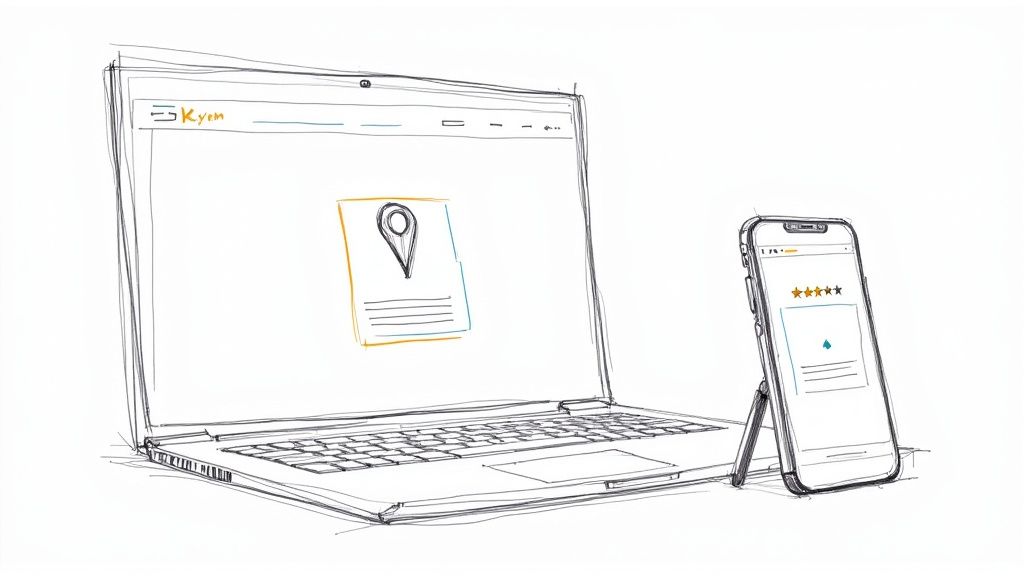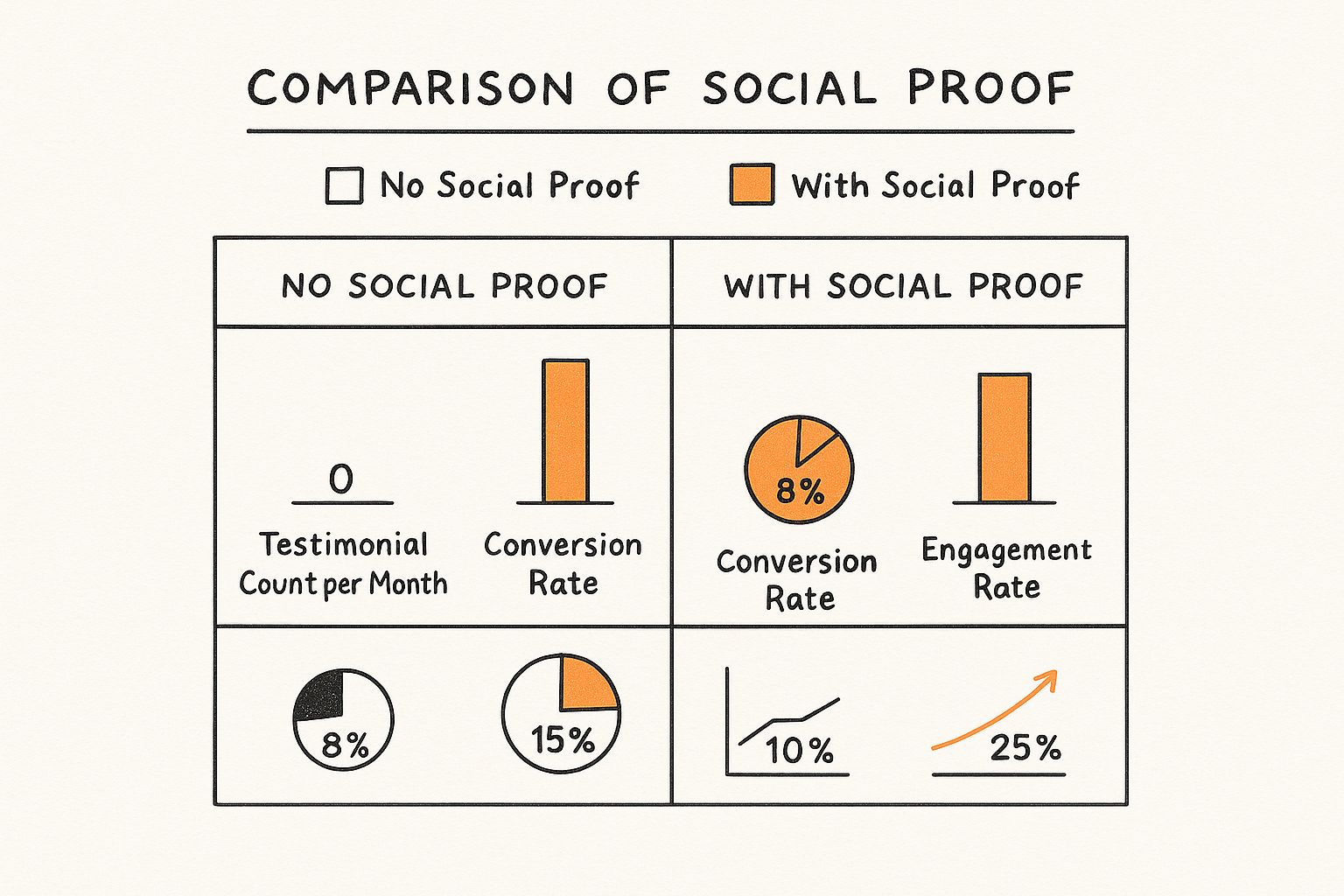
In short 👇🏽
Promoting a Gym: No-Nonsense Growth Strategies
This article is proposed by Gymkee, the personal trainer software that allows you to deliver the best coaching experience to your clients while saving time and growing your personal training business.
Try Gymkee for free for 14 daysBefore you run a single ad, get your gym’s digital house in order. This is the foundation everything else is built on. It starts with a website that shows up in local searches and a Google Business Profile tuned to catch people exactly when they’re looking for a new place to train.
Building Your Gym's Digital Foundation
Spending money on ads before your online presence is ready is like trying to fill a leaky bucket. Potential members will just slip through. Your website and local listings are your digital front door. If it’s confusing, slow, or unappealing, they’ll walk right by.
A weak foundation will sabotage any marketing campaign, wasting your time and budget. The goal is simple: create an online presence that gets people in the door for a tour or a trial class.

Nail Your Website Essentials
Your website is often the first interaction a potential member has with your brand. It has to do more than just exist—it must convert browsers into clients.
Ensure your site has these non-negotiables:
- Mobile-First Design: Most people will find you on their phone. Your site must be fast and easy to navigate on a small screen. No excuses.
- Clear Calls-to-Action (CTAs): Don't make people hunt for what to do next. Buttons like "Claim Your Free Pass," "Book a Tour," or "View Class Schedule" should be impossible to miss.
- High-Quality Visuals: Ditch generic stock photos. Use professional photos and videos of your actual gym and members (with their permission). Real people and real spaces build trust.
- Simple Navigation and Pricing: Your class schedule, membership options, and contact info must be easy to find. Hiding your prices creates frustration and sends potential members to your competitors.
For a deeper look at creating a site that converts, our guide on building a personal trainer website has practical insights that apply to any fitness business.
Dominate Local Search with Google Business Profile
For a local business like a gym, your Google Business Profile (GBP) is your most powerful free marketing tool. When someone searches "gym near me," a well-managed GBP gets you to the top of the map pack.
Your Google Business Profile isn't a static listing; it's an interactive storefront. Consistently updating it signals to Google that your business is active and relevant, which directly impacts your ranking in local searches.
Claim and verify your profile. Then, treat it like an active marketing channel:
- Complete Every Section: Fill out every field Google provides—services, amenities, hours, health and safety info. The more detail, the better.
- Use High-Resolution Photos: Regularly upload new, high-quality photos of your facility, equipment, classes, and staff. Keep it fresh.
- Encourage and Respond to Reviews: Actively ask happy members to leave a review. Respond to every single one—good and bad. It shows you're engaged and you care.
- Use Google Posts: Use the "Posts" feature at least once a week to announce a new class, share a member success story, or run a promotion. This keeps your profile active.
Mastering Hyperlocal Marketing for Member Growth
Forget broad campaigns. The lifeblood of your gym is the community right outside your front door. The most loyal, consistent members are the ones who live or work just a few minutes away. To promote a gym effectively, you have to dominate this hyperlocal market with authentic, community-focused strategies that build trust and drive growth.
This is about becoming a recognized, valued part of your neighborhood—the go-to fitness hub for locals. That requires forging real-world connections, not just digital ones.

Forge Powerful Local Partnerships
Create mutually beneficial referral streams with other local businesses. Where do your ideal members already shop, eat, and spend their time? Those are your future partners.
Reach out to businesses that serve a similar health-conscious crowd but aren't direct competitors. This positions your gym as a core piece of the local wellness ecosystem.
Actionable partnership ideas:
- Health Food Stores: Offer their customers an exclusive one-week free trial at your gym. In return, give your members a discount coupon for their store. A simple win-win.
- Physical Therapy Clinics: Develop a post-rehab fitness program. Become the trusted place they refer patients to continue building strength safely after treatment.
- Corporate Offices: Pitch a corporate wellness package with discounted memberships. Offer to host a free "Wellness Wednesday" lunch-and-learn at their office to give them a taste of what you offer.
For any gym, mastering the local scene is critical. This means solid local SEO strategies for small business are non-negotiable to ensure your digital visibility backs up your physical community presence.
Turn Your Gym into a Community Hub
Your facility needs to be more than just a place to work out; it should be a destination. Hosting events transforms your space into a social hub, creating organic opportunities for member referrals and attracting new people. These events don't have to be complex or expensive.
The best hyperlocal marketing feels less like marketing and more like community-building. When you provide value beyond the workout, you create advocates who will promote your gym for you.
For example, host a free monthly workshop on "Nutrition for Busy Professionals" or "A Beginner's Guide to Foam Rolling." Invite a local nutritionist or physical therapist to co-host to double your promotional reach. You can learn more about how to get clients without ads by leaning into these value-driven, community-first initiatives.
Creating Social Proof and Content That Converts
Your social media and blog should be more than a highlight reel of workout clips. To promote your gym, your content needs to work 24/7 to build trust and show your value before someone even walks through your doors.
Stop just posting and start creating resources that solve problems for the people you want to attract. Someone at the beginning of their fitness journey is likely searching for "beginner workout plans" or "how to use gym equipment." If you create high-quality content answering those exact questions, you instantly position your gym as a welcoming authority for newcomers. This turns your content from something that's seen into something that's useful—the first step to converting a follower into a paying member.
Turn Members into Your Best Marketers
The most powerful content you can share is created by your members. Social proof—testimonials, transformation stories, and raw video reviews—is marketing gold. It’s authentic, relatable, and people trust other people more than they trust a brand.
Be systematic about gathering this content. Don't just hope it happens.
- Set up an automated email. A few weeks after a new member joins, send an automated email asking about their experience. Make it simple for them to reply with a quote.
- Run quarterly challenges. Host a transformation challenge and get professional photos of the winners. Their stories become visual proof that you deliver results.
- Just ask for a video. When a member hits a new PR or gives you positive feedback, ask them on the spot: "Hey, would you mind recording a quick video on your phone saying that?" Unedited, off-the-cuff clips often perform best.
With tens of thousands of fitness facilities in the market, social proof is what will make you the obvious choice in a crowded space.
Showcase Results to Drive Action
Collecting testimonials is only half the battle. You have to put them everywhere. Feature them prominently on your website's homepage, create dedicated "Results" pages, and repurpose them as social media posts.
This isn't just a "nice-to-have." Look at the direct impact of showcasing social proof on key marketing metrics.

The data is clear. Systematically collecting and sharing testimonials can significantly boost engagement and conversion rates. To ensure your content connects and doesn't feel stale, stay on top of what's working on platforms like TikTok and Instagram by understanding current short-form video trends.
A constant flow of authentic member stories creates a powerful feedback loop. New prospects see real people achieving real results, which builds trust and makes them far more likely to sign up.
Designing Irresistible Offers and Referral Programs
https://www.youtube.com/embed/g_-LSmes6zc
The generic "10% off" coupon isn't enough. When promoting a gym, your offers need to be strategic invitations that solve a real problem for your target audience. The goal isn't just to get bodies in the door; it's to attract committed, long-term clients, not deal-seekers who vanish after a month.
Package your services as a complete solution. Instead of selling gym access, sell a result—a transformation. This shift is what turns a browser into a committed member.
Crafting Offers That Actually Work
The best offers tap directly into the goals of your ideal member. A beginner might feel overwhelmed by a standard membership but will jump at a structured challenge promising clear guidance and an achievable outcome.
Here are proven offer structures that get people to take action:
- The 30-Day Challenge: Creates urgency and gives people a clear timeline for results. Package it with group training sessions, a simple nutrition guide, and before-and-after check-ins.
- Introductory Personal Training Pack: Many people are curious about personal training but are hesitant about the price. Offer a low-commitment pack of three sessions for a special price. This lets them experience the value firsthand, making them more likely to sign up for more.
- Class Bundles: Perfect for those interested in specific classes like yoga or HIIT. Offer a 10-class pass at a better per-class rate than your drop-in fee. It encourages repeat visits without the pressure of a full membership.
Post-pandemic, U.S. gym memberships rebounded to pre-2020 levels, indicating a large pool of motivated people looking for the right gym. A smart offer is often what gets them to choose you. You can learn more about how gym membership trends are evolving.
Gym Promotion Strategy Comparison
Choosing the right promotional strategy can be overwhelming. This table breaks down common tactics to help you decide where to focus your energy, comparing their cost, effort, and typical impact.
Each strategy serves a different purpose. A 30-day challenge is great for a quick influx of new faces, while a referral program is a slow-burning engine for long-term growth. Align your promotion with your immediate business goals.
Building a Referral Engine That Runs Itself
Your happiest members are your best and cheapest marketing channel. A great referral program needs structure and the right incentives to make it effortless for members to spread the word.
The most successful referral programs use a dual-incentive system. By rewarding both the existing member and the new sign-up, you remove friction and make everyone feel like they're getting a good deal.
For example, offer the referring member $50 off their next month's dues while their friend gets their first month for 50% off. This is a powerful incentive that people will actually share.
Automate the process. Give members simple email templates and social media posts they can use with a single click. This turns your community into a proactive growth engine.
Turn Your Gym Into a Community to Keep Members for Life
Getting a new member is just the first step. The key to a profitable, sustainable gym is keeping them. This means shifting your focus from selling memberships to building a genuine community.
When you transform your facility from a place people work out into a place they belong, everything changes. Friendships form, and leaving your gym means leaving a part of their social life behind. That is a powerful defense against member churn. The best way to do this is by hosting engaging events.

Go Beyond Workouts With Events People Actually Enjoy
Your events calendar shouldn't just be more fitness classes. The goal is to create shared experiences that build bonds between your members. These don’t need to be expensive or complicated; what matters is consistency and genuine effort.
Try mixing up your events to see what resonates:
- Member Appreciation BBQs: A simple cookout in the parking lot or a nearby park is a low-pressure way for members and staff to connect outside of a training session.
- Themed Workout Nights: "80s Aerobics Night" or a "Superhero Circuit." Fun, lighthearted events encourage teamwork and create memorable moments.
- Educational Workshops: Team up with a local nutritionist or physical therapist for a free workshop on topics like "Meal Prep Basics" or "Mobility for Desk Workers." This adds value beyond the squat rack and positions you as a wellness expert.
The environment should make members see each other as friends, not just strangers on adjacent treadmills. According to IHRSA data cited by Placer.ai, foot traffic trends show budget gyms booming and engagement up across segments. As more people come through your doors, a strong community becomes your biggest advantage. You can dig into more details with these 2025 fitness industry foot traffic trends.
Keep the Conversation Going Between Events
Community-building can't stop when an event ends. Keep the feeling of belonging alive between get-togethers. Your digital communication is as crucial as your in-person interactions.
For many people, the gym is their 'third place'—a social hub outside of home and work. Your communication should reflect that. Celebrate your members, help them connect, and make them feel seen.
Simple communication tactics to keep the community strong:
- Member of the Month Spotlights: Each month, feature a different member on social media and on a bulletin board inside the gym. Share their story, progress, and what they love about the community.
- Private Group Forums: A "members-only" Facebook Group or Discord server gives people a private space to ask questions, celebrate wins, and organize their own meetups, strengthening their ties to each other and to your brand.
This type of consistent communication should be part of the member journey from day one. To nail that initial experience, check out these client onboarding best practices.
Got Questions About Gym Promotion?
Here are no-fluff answers to common questions from gym owners.
What's The Best Way To Track Marketing ROI?
Track your Return on Investment (ROI) by tracing every lead back to its source. Use unique phone numbers for flyers, specific landing pages for online ads, or different discount codes for each campaign.
For example, a Facebook ad campaign should point to a unique landing page like yourgym.com/facebook-offer. When a new member signs up through that page, you know with certainty that your Facebook ad budget brought them in.
My rule is simple: if you can't track it, don't do it. The goal is to calculate your Customer Acquisition Cost (CAC) for each channel and compare it to the Lifetime Value (LTV) of a member. A healthy LTV to CAC ratio is 3:1 or better.
How Much Should A New Gym Spend On Advertising?
There is no magic number, but a solid benchmark for a new gym is to earmark 10-15% of your projected gross revenue for marketing during the first year. This is aggressive, but in the beginning, your only job is to build awareness and get people through the door.
A suggested budget split:
- 40% on digital ads: Google Local and social media ads to capture people actively looking for a gym.
- 30% on local marketing: Sponsoring a 5K or putting up flyers at a local coffee shop to build a community presence.
- 20% on content creation: Professional photos and videos are the fuel for all your digital marketing.
- 10% for experiments: Try a new platform or a different campaign idea.
Once you have a steady flow of members, adjust this budget based on what the data shows is working.
Digital Marketing Or Local Events? Which Is Better?
Wrong question. Don't choose one over the other—they work best together. Digital marketing reaches a broad audience, while local events build face-to-face trust.
Think of it as your "air game" and your "ground game."
- Air Game (Digital): Use targeted ads and SEO so everyone in a five-mile radius of your gym knows you exist.
- Ground Game (Local): Host an open house or partner with a local juice bar. This turns digital awareness into a physical handshake.
The pro move is to use your digital ads to promote your local event, creating a synergy that fills the room.
What Are The Most Common Gym Marketing Mistakes?
The biggest mistake is inconsistency. Owners get excited, run ads for a month, don't see immediate results, and then stop. Effective gym promotion is like a workout program—it only works if you stick with it consistently over time.
The other major error is trying to market to everyone.
If you try to be the perfect gym for hardcore bodybuilders, yoga enthusiasts, and seniors all at once, you'll connect with none of them. Define your ideal member and aim every piece of your marketing—from ad copy to class schedules—directly at that person. A focused message is a powerful message.
Ready to streamline your coaching and give your clients a world-class experience? Gymkee is the all-in-one platform that saves you hours on program design, nutrition planning, and client management. Start your 14-day free trial today at https://www.gymkee.io and see why over 3,000 trainers trust us to grow their business.
.svg)